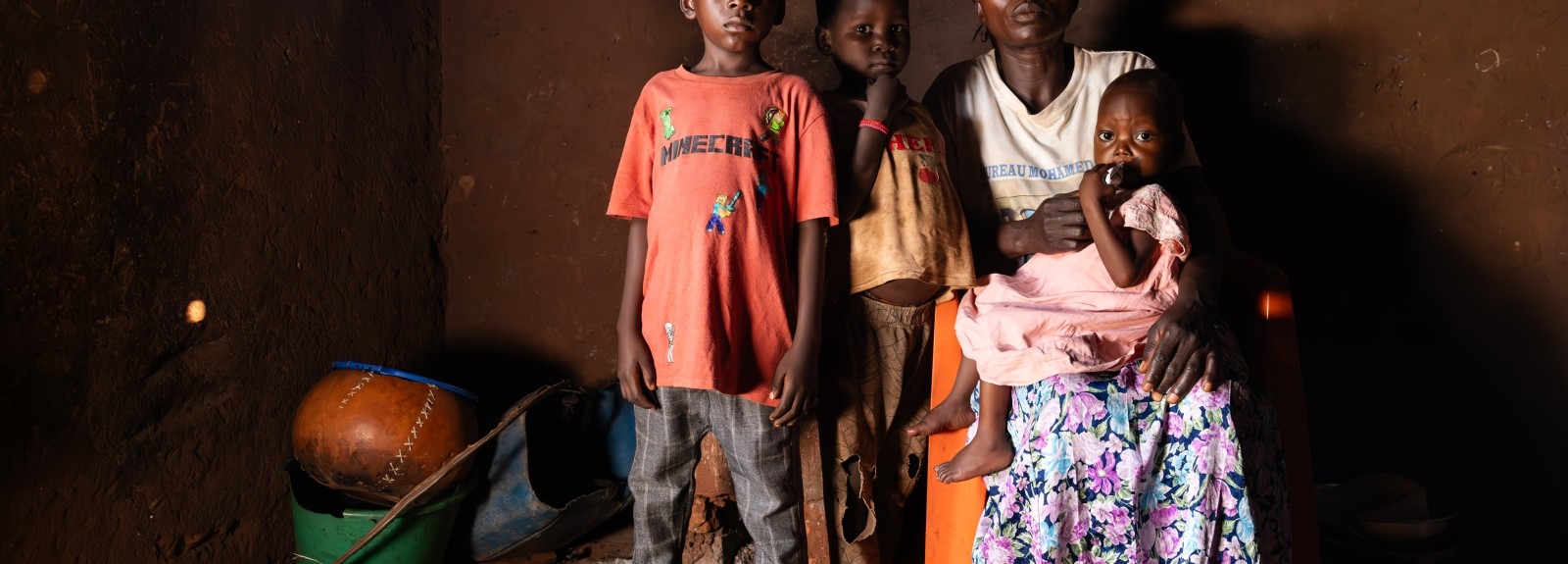Ngalula Makenga is originally from Kananga in the Democratic Republic of Congo’s (DRC) Kasai Central. When the Kamuina Nsapu rebellion exploded into a war that spread across the Kasais, her and her family had to flee their home. Life has been a struggle ever since.
They now live in Kamonia, Kasai, a remote mining town in the south of Kasai province. Her husband works in the diamond mines and is gone for months at a time, leaving her to care for their eight children alone. She earns what she can washing clothes for people in her village and fetching water from the river, which is about an hour’s walk away from the small mud hut she shares with her children. She says sometimes she can fetch five basins of water in one day. If she can fit a load of laundry in too, she can make around $1.40 per day.
That is not enough for her family to survive. She is only able to feed them once per day, just before they go to bed. Her 32-month-old daughter Tshituka is visibly ill. Her arms are too thin, her stomach extended, and her eyes shine large and bright in her gaunt face. She has been suffering from malnutrition for more than a year now. Ngalula has taken her for treatment at the health center several times. Each time they prescribe several rounds of Plumpy’Nut, a peanut-based paste designed to treat severe acute malnutrition, and she gets better. As soon as she goes off the treatment, however, she begins wasting again.
Malnutrition in DRC
This is a story shared by many in DRC, where approximately six million children suffer from chronic malnutrition. This contributes to the prevalence of stunting in the country, which often has devastating consequences on the cognitive development of children, impacting their future health outcomes negatively.
For Ngalula, the consequences have been far worse. Two months ago, she lost her third child to anemia, a symptom of malnutrition which, if left untreated, can be life threatening. She says, “The blood was finished; I gave my own blood, but he died.” She goes on, “The one who died in Kananga was three years and six months old. The other one died while fleeing the war due to lack of food. He died when he was two years and six months old.”
Tshituka attends a nutrition screening at her local PMNS-supported health center.
Ending severe acute malnutrition in DRC
Corus organization IMA World Health is leading a consortium of partners to implement the Multisectoral Nutrition and Health (PMNS) project in DRC to change this outcome for families like Ngalula’s. In July 2024, IMA World Health completed its first round of trainings of hundreds of community health workers (CHW) in Kamonia. These CHWs will be going house to house in villages to educate communities on the signs of malnutrition and how to treat and prevent it.
Funded by the World Bank and managed through the Government of DRC’s Health System Strengthening Program (PDSS), the PMNS project supports the DRC’s Ministry of Health to increase access to and use of a package of community-based nutrition services and support the improvement and integration of nutrition services in health facilities to reduce the level of malnutrition in Kasai province.
When the trainings have been completed across Kasai, more than 14,000 community representatives will be armed with the knowledge and tools to combat malnutrition once and for all. These trainings are part of the province-wide Community-Based Nutrition Initiative, known locally as NAC, which in French stands for Nutrition à Assise Communautaire. The trainings are the second of seven steps villages across Kasai are taking to certify themselves with the capacity to take malnutrition into their own hands.
The seven-step process includes:
1. Organize the community into community participation bodies where the community elects its own representatives in the form of RECOs and CODESA* members
2. Strengthen the capacity of elected representatives through trainings
3. Diagnosis with the community through focus group discussions in each community to help identify community-specific causes of malnutrition and how best to prevent it
4. Develop a plan to reduce incidence of malnutrition tailored to local context
5. Implement the plan
6. Conduct community assessments
7. Health zone staff assess community and certify
Ngalula Makenga can only afford to feed her family one simple meal per day.
Dr. Narcisse, NAC coordinator, says, “The focus groups examine what are the local causes of malnutrition within the community and, based on these causes, the community offers local solutions. Based on these solutions, it devises an implementation plan, a local plan to fight malnutrition.”
Community leaders talk with the community about the causes of malnutrition during a focus group discussion in Kamonia, DRC.
Going door to door to combat malnutrition
Soon, RECOs will be visiting the home of Ngalula and Tshituka to demonstrate how to cook an enriched porridge made from local ingredients found at the market. Ngalula will be able to nourish her daughter back to health in her own home, no longer relying on prescriptions of Plumpy’Nut. Ngalula will also have the opportunity to join a village savings and loan association (VSLA), which could help her invest in new streams of income.
She says, “If they helped me, I would go work in the fields. Cultivate. If they gave me money, I would go into business. I would buy goods to sell and find a way to get food.”
For Ngalula, this dream could soon be a reality.
* RECOs, or relais communautaire, are community health workers in DRC, and CODESAs are community health committees.

